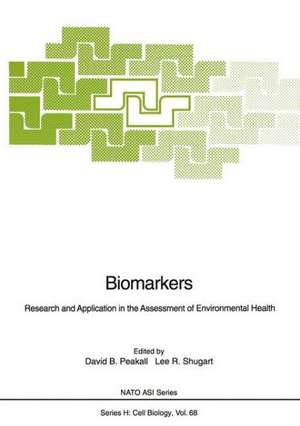Biomarkers: Research and Application in the Assessment of Environmental Health: Nato ASI Subseries H:, cartea 68
Editat de David B. Peakall, Lee R. Shugarten Limba Engleză Paperback – 15 dec 2011
Din seria Nato ASI Subseries H:
- 18%
 Preț: 953.82 lei
Preț: 953.82 lei -
 Preț: 393.13 lei
Preț: 393.13 lei - 15%
 Preț: 643.34 lei
Preț: 643.34 lei - 15%
 Preț: 643.34 lei
Preț: 643.34 lei - 15%
 Preț: 641.03 lei
Preț: 641.03 lei - 15%
 Preț: 642.83 lei
Preț: 642.83 lei - 15%
 Preț: 642.51 lei
Preț: 642.51 lei - 5%
 Preț: 712.81 lei
Preț: 712.81 lei -
 Preț: 392.97 lei
Preț: 392.97 lei - 15%
 Preț: 651.02 lei
Preț: 651.02 lei - 15%
 Preț: 640.24 lei
Preț: 640.24 lei - 18%
 Preț: 948.61 lei
Preț: 948.61 lei - 15%
 Preț: 655.92 lei
Preț: 655.92 lei - 15%
 Preț: 655.92 lei
Preț: 655.92 lei - 15%
 Preț: 653.14 lei
Preț: 653.14 lei - 15%
 Preț: 650.19 lei
Preț: 650.19 lei - 15%
 Preț: 655.13 lei
Preț: 655.13 lei - 15%
 Preț: 652.17 lei
Preț: 652.17 lei - 15%
 Preț: 675.58 lei
Preț: 675.58 lei - 18%
 Preț: 958.07 lei
Preț: 958.07 lei - 18%
 Preț: 961.41 lei
Preț: 961.41 lei - 18%
 Preț: 970.56 lei
Preț: 970.56 lei - 5%
 Preț: 1100.30 lei
Preț: 1100.30 lei - 5%
 Preț: 376.43 lei
Preț: 376.43 lei - 15%
 Preț: 650.86 lei
Preț: 650.86 lei - 15%
 Preț: 644.63 lei
Preț: 644.63 lei - 15%
 Preț: 655.60 lei
Preț: 655.60 lei - 18%
 Preț: 963.47 lei
Preț: 963.47 lei - 15%
 Preț: 648.42 lei
Preț: 648.42 lei - 5%
 Preț: 731.43 lei
Preț: 731.43 lei - 15%
 Preț: 653.14 lei
Preț: 653.14 lei - 18%
 Preț: 960.13 lei
Preț: 960.13 lei - 18%
 Preț: 968.34 lei
Preț: 968.34 lei - 18%
 Preț: 953.97 lei
Preț: 953.97 lei - 15%
 Preț: 654.95 lei
Preț: 654.95 lei - 15%
 Preț: 652.49 lei
Preț: 652.49 lei - 15%
 Preț: 650.86 lei
Preț: 650.86 lei - 5%
 Preț: 367.64 lei
Preț: 367.64 lei - 5%
 Preț: 1104.68 lei
Preț: 1104.68 lei - 18%
 Preț: 953.20 lei
Preț: 953.20 lei - 15%
 Preț: 651.99 lei
Preț: 651.99 lei - 15%
 Preț: 647.27 lei
Preț: 647.27 lei - 15%
 Preț: 653.00 lei
Preț: 653.00 lei - 15%
 Preț: 656.25 lei
Preț: 656.25 lei - 18%
 Preț: 962.35 lei
Preț: 962.35 lei - 15%
 Preț: 644.82 lei
Preț: 644.82 lei - 15%
 Preț: 666.55 lei
Preț: 666.55 lei - 15%
 Preț: 642.68 lei
Preț: 642.68 lei - 15%
 Preț: 645.96 lei
Preț: 645.96 lei - 15%
 Preț: 651.84 lei
Preț: 651.84 lei
Preț: 634.32 lei
Preț vechi: 746.26 lei
-15% Nou
Puncte Express: 951
Preț estimativ în valută:
121.37€ • 126.73$ • 100.45£
121.37€ • 126.73$ • 100.45£
Carte tipărită la comandă
Livrare economică 04-18 aprilie
Preluare comenzi: 021 569.72.76
Specificații
ISBN-13: 9783642846335
ISBN-10: 3642846335
Pagini: 148
Ilustrații: XIX, 119 p.
Dimensiuni: 170 x 242 x 8 mm
Greutate: 0.25 kg
Ediția:Softcover reprint of the original 1st ed. 1993
Editura: Springer Berlin, Heidelberg
Colecția Springer
Seria Nato ASI Subseries H:
Locul publicării:Berlin, Heidelberg, Germany
ISBN-10: 3642846335
Pagini: 148
Ilustrații: XIX, 119 p.
Dimensiuni: 170 x 242 x 8 mm
Greutate: 0.25 kg
Ediția:Softcover reprint of the original 1st ed. 1993
Editura: Springer Berlin, Heidelberg
Colecția Springer
Seria Nato ASI Subseries H:
Locul publicării:Berlin, Heidelberg, Germany
Public țintă
ResearchCuprins
1. Applications and Objectives of Biomarker Research.- 1.1. Introduction.- 1.2. Definitions.- 1.3. Objectives of Biomarker Programs.- 1.4. Applications of Biomarker Programs.- 1.5. Rationale for the use of Biomarkers.- 1.6. Current Limitations in the use of Biomarkers.- 1.7. Future of Biomarkers in Environmental Assessment.- 1.8. Literature Cited.- 2. The Conceptual Basis of the Biomarker Approach.- 2.1. Introduction.- 2.2. Dose-Response Relationships.- 2.3. Physiological Alterations as a Basis for Biomarkers.- 2.4. Considerations in the use of Biomarkers.- 2.5. Future Prospects.- 2.6. Literature Cited.- 3. Implementation of Biomarker-Based Studies.- 3.1. Introduction.- 3.2. Selection and Characterization of Study Sites.- 3.3. Selection of Species.- 3.4. Biomarker Selection.- 3.5. Sampling Methodology.- 3.6. Analysis.- 3.7. Summary.- 3.8. Literature Cited.- 4. Interpretation of Biomarker Responses.- 4.1. Introduction.- 4.2. Biological Interpretation of Biomarkers.- 4.3. Statistical and Mathematical Techniques for Interpretation.- 4.4. Societal Interpretations.- 4.5. Literature Cited.- 5. Development and Validation of Biomarkers.- 5.1. Introduction.- 5.2. The Ideal Biomarker.- 5.3. Development of new Biomarkers.- 5.4. Validation.- 5.5. Literature Cited.- 6. Conceptual Strategy for Development and Application of a Biomarker-Based Biomonitoring Program.- 6.1. Definition of Study Objectives.- 6.2. General Elements of a Biomarker-Based Biomonitoring Study.- 6.3. Tailoring Study Design for Specific Objectives.- 6.4. Development of Biomarkers: Laboratory and Field Studies.- 6.5. Literature Cited.












